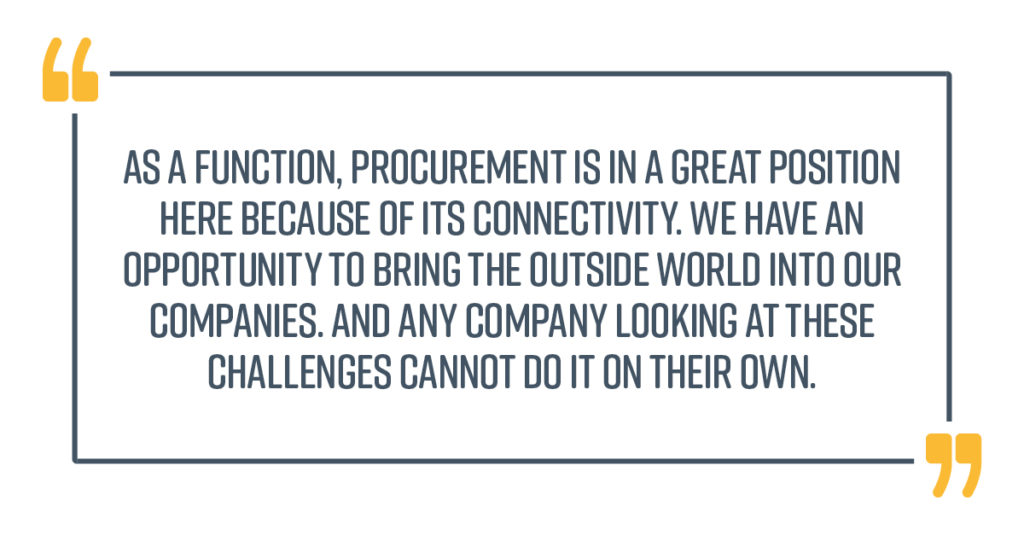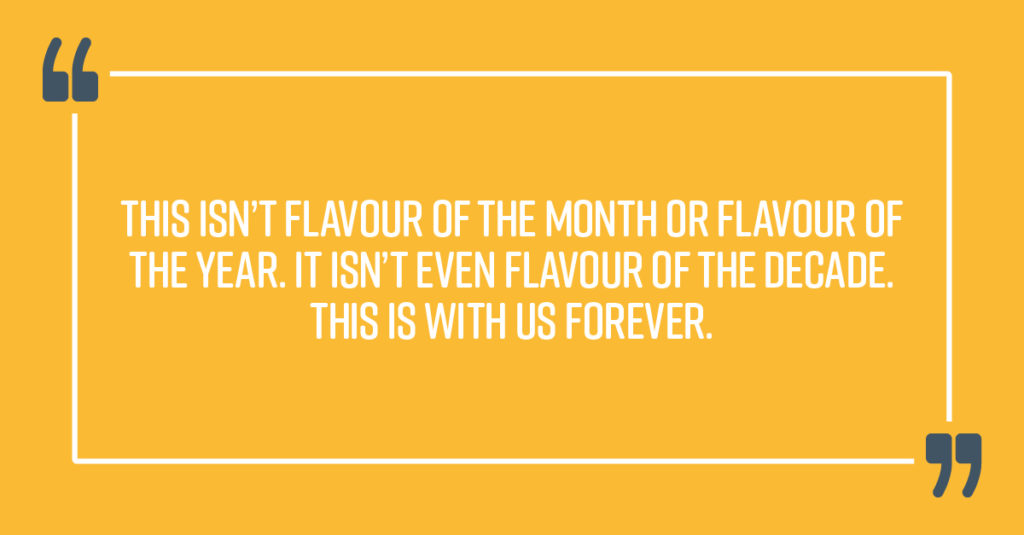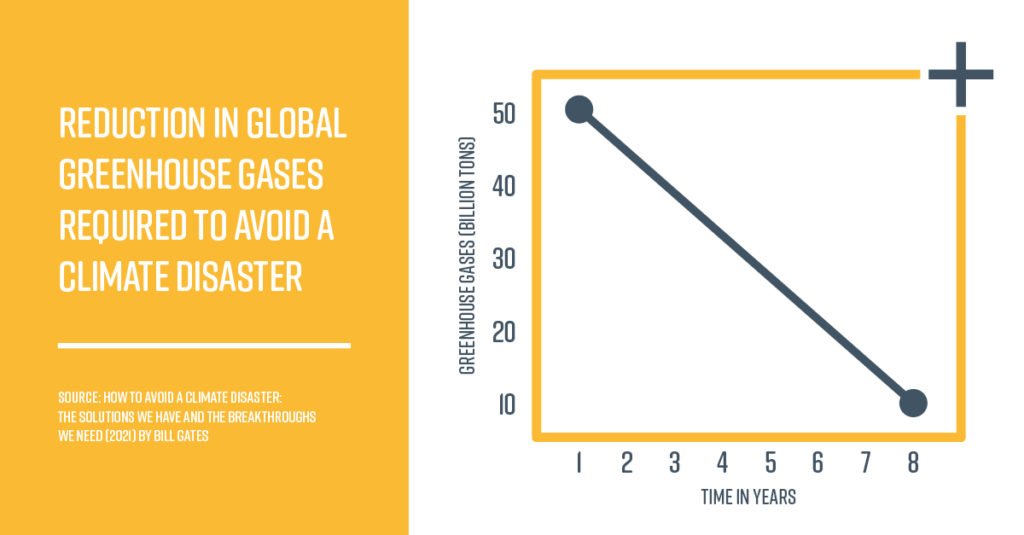Chris Holmes, Senior Vice President Global Sourcing at Avantor in Basel and Sustainable Procurement Ambassador with the Sustainable Procurement Pledge, talks about the role procurement professionals can play in driving progress towards a circular economy.
These days, most companies focus on sustainability, but the circular economy goes the extra mile. Put simply, it’s about not consuming resources in the first place, as opposed to recycling them.

As a function, procurement is in a great position here because of its connectivity. We have an opportunity to bring the outside world into our companies. And any organization looking at these challenges cannot do it on its own. Collaboration just has to happen.
Business Ambition
The challenge is business-wide, but procurement functions can begin to implement things now. First, we need to understand the business ambition which should frame the activity. This is the drive and tone from the top that binds it together and says, ‘This is our ambition as a company. This is where we want to go. This is how we want to act and be perceived.’
Inevitably, procurement will need to partner with other internal departments, such as finance, quality and sales to achieve a cross-functional effort.
We may need to redesign completely what we do. Some companies in the supply chain are far more advanced on the topic, presenting opportunities to collaborate. The concepts of the circular economy and sustainability become perfect anchors for long-term innovation programs. We need to get deep into the supply base to understand the whole ecosystem.
Culture
Typically, if you buy something today, you don’t have to care what happens once it’s been shipped to the customer. It’s not your problem, or it never was in the past. Now it is. And that’s a fundamental shift. Now we have to think about what happens to the product after it leaves us and whether we bring it back, recycle or remake it.
How do we rethink the way that procurement operates? If we’ve spent our lives squeezing the lemon with our supply base, it’s hard then to say, ‘Now we want to collaborate.’ Suppliers will, understandably, be mistrustful.
In some sense, we are ready because of the recent focus on responsible procurement. Much work on assessing and qualifying companies and understanding risk has been done. What’s needed now is to layer in those risks around climate elements.
Driving change
Some firms claim to recycle old products and use this for positive PR. As responsible procurement professionals we must understand what’s actually happening, rather than accepting what we are told. Everything that seems green isn’t necessarily green.
We trust the companies we buy from and, similarly, our suppliers trust those that they buy from, but how do we drive change with the whole value chain?
A collaborative discussion somewhat outside traditional talk of issues such as price and delivery performance, provides an opportunity for partnerships that won’t affect our commercial position, but will benefit all involved and may even improve competitive position.
With immediate suppliers, such conversations are reasonably straightforward because we have a contractual relationship. Further-up the supply chain, it becomes more difficult, especially if we suspect unsustainable use of resources through emissions or human impact such as forced or child labour.
Again, it returns to responsible procurement – not to say that’s a panacea and we understand every step in the chain. There are, after all, enough news stories to prove otherwise. Fundamentally, it’s no longer enough to have that one-to-one relationship or just about the supply chain. It is much broader. Unexpected partnerships will emerge with other companies, organizations and even academic institutions, and it will be fascinating to see these collaborations grow.

The issue of our times
From a global perspective, this is the issue of our times. This isn’t flavour of the month or flavour of the year. It isn’t even flavour of the decade. This is with us forever. The focus may shift but the seriousness with which businesses now regard it is different.
People are committing to this in their personal lives. There is not just a top-down push, but also a bottom-up push. That’s what the Sustainable Procurement Pledge is focused on, us as individuals as opposed to our corporate role, so that we make that groundswell of change around environmental issues.
Taking action
We cannot afford to do nothing. To put it bluntly, we’d all be screwed. While there are differing views on the impact of climate change, the evidence says we aren’t going to get where we need to. As an avid skier living in Switzerland, I see the impact on the snow and glaciers. I don’t claim to fully understand it , but frankly I do find it pretty scary. Targets that talk about 2030 or 2050 seem a long way off and it feels like this is only accelerating.
These are complex issues. Some may be easier to move more quickly than others and rumored European legislation that might make companies more accountable for what happens in their supply chain seems slow. It will be interesting to see if a carbon tax is introduced because that could really drive a change in behavior, but you stop an industry using coal overnight and you’re putting a lot of people out of work. That’s a problem for governments and it’s not an easy balance, that’s for sure.
Bill Gates recently said in his book, we’ve got to get the 51 billion tons of greenhouse gases each year down to zero within the next eight years if we stand a chance of getting this under control.

Three steps to making the circular economy happen
- Hearts and minds
There’s a massive groundswell of opinion and action at a personal level, but a procurement individual in a company should consider how the C-suite thinks about this. Are you plugged into that and part of that discussion? If not, can you force your way in? It’s that tone from the top that says, ‘This is what we need to do.’
- Promote success
In any company, there’s a lot going on that you probably don’t realize. Highlight those stories to show how things can change. It really helps to spread the word.
- Shift the mindset
At an individual level, start to say, ‘Where can I make an impact? Where are the places to start? Which are the suppliers and supply chains that I can work with? And what would be the impact of doing something in that space?’ Whether it’s around precious metals, chemicals, or plastics, try to figure out where to begin to build those future stories that help to shift the mindset.
By focusing on these three things, you will be able to figure out how to drive that change.
Written by, Chris Holmes, Senior Vice President Global Sourcing at Avantor in Basel and Sustainable Procurement Ambassador with the Sustainable Procurement Pledge.

